Drug delivery to solid tumors by elastin-like polypeptides
- PMID: 20546809
- PMCID: PMC2940962
- DOI: 10.1016/j.addr.2010.05.004
Drug delivery to solid tumors by elastin-like polypeptides
Abstract
Thermally responsive elastin-like polypeptides (ELPs) are a promising class of recombinant biopolymers for the delivery of drugs and imaging agents to solid tumors via systemic or local administration. This article reviews four applications of ELPs to drug delivery, with each delivery mechanism designed to best exploit the relationship between the characteristic transition temperature (T(t)) of the ELP and body temperature (T(b)). First, when T(t)≫T(b), small hydrophobic drugs can be conjugated to the C-terminus of the ELP to impart the amphiphilicity needed to mediate the self-assembly of nanoparticles. These systemically delivered ELP-drug nanoparticles preferentially localize to the tumor site via the EPR effect, resulting in reduced toxicity and enhanced treatment efficacy. The remaining three approaches take direct advantage of the thermal responsiveness of ELPs. In the second strategy, where T(b)<T(t)<42°C, an ELP-drug conjugate can be injected in conjunction with external application of mild hyperthermia to the tumor to induce ELP coacervation and an increase in concentration within the tumor vasculature. The third approach utilizes hydrophilic-hydrophobic ELP block copolymers that have been designed to assemble into nanoparticles in response to hyperthermai due to the independent thermal transition of the hydrophobic block, thus resulting in multivalent ligand display of a ligand for spatially enhanced vascular targeting. In the final strategy, ELPs with T(t)<T(b) are conjugated with radiotherapeutics, injtect intioa tumor where they undergo coacervation to form an injectable drug depot for intratumoral delivery. These injectable coacervate ELP-radionuclide depots display a long residence in the tumor and result in inhibition of tumor growth.
Copyright © 2010 Elsevier B.V. All rights reserved.
Figures


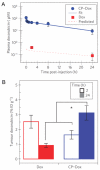
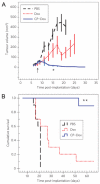



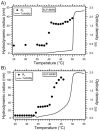
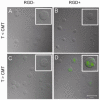

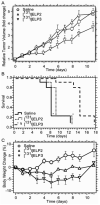
Similar articles
-
Injectable intratumoral depot of thermally responsive polypeptide-radionuclide conjugates delays tumor progression in a mouse model.J Control Release. 2010 May 21;144(1):2-9. doi: 10.1016/j.jconrel.2010.01.032. Epub 2010 Jan 31. J Control Release. 2010. PMID: 20117157 Free PMC article.
-
Rational design of "heat seeking" drug loaded polypeptide nanoparticles that thermally target solid tumors.Nano Lett. 2014 May 14;14(5):2890-5. doi: 10.1021/nl5009376. Epub 2014 Apr 21. Nano Lett. 2014. PMID: 24738626 Free PMC article.
-
Multivalent Targeting Based Delivery of Therapeutic Peptide using AP1-ELP Carrier for Effective Cancer Therapy.Theranostics. 2016 Sep 25;6(12):2235-2249. doi: 10.7150/thno.16425. eCollection 2016. Theranostics. 2016. PMID: 27924160 Free PMC article.
-
Genetically Encoded Elastin-Like Polypeptides for Drug Delivery.Adv Healthc Mater. 2021 Jul;10(13):e2100209. doi: 10.1002/adhm.202100209. Epub 2021 Jun 3. Adv Healthc Mater. 2021. PMID: 34080796 Review.
-
Elastin-like polypeptides and their applications in anticancer drug delivery systems: a review.Drug Deliv. 2015 Feb;22(2):156-67. doi: 10.3109/10717544.2013.853210. Epub 2013 Nov 12. Drug Deliv. 2015. PMID: 24215207 Review.
Cited by
-
Synthesis and Immunogenicity Assessment of Elastin-Like Polypeptide-M2e Construct as an Influenza Antigen.Nano Life. 2014 Jun 1;4(2):1450004. doi: 10.1142/s1793984414500044. Nano Life. 2014. PMID: 25825595 Free PMC article.
-
Effect of detergents on the thermal behavior of elastin-like polypeptides.Biopolymers. 2013 Jan;99(1):55-62. doi: 10.1002/bip.22137. Biopolymers. 2013. PMID: 23097230 Free PMC article.
-
Local drug delivery strategies for cancer treatment: gels, nanoparticles, polymeric films, rods, and wafers.J Control Release. 2012 Apr 10;159(1):14-26. doi: 10.1016/j.jconrel.2011.11.031. Epub 2011 Dec 1. J Control Release. 2012. PMID: 22154931 Free PMC article. Review.
-
Computational smart polymer design based on elastin protein mutability.Biomaterials. 2017 May;127:49-60. doi: 10.1016/j.biomaterials.2017.01.041. Epub 2017 Jan 31. Biomaterials. 2017. PMID: 28279921 Free PMC article.
-
Genetically Encoded XTEN-based Hydrogels with Tunable Viscoelasticity and Biodegradability for Injectable Cell Therapies.Adv Sci (Weinh). 2024 Jun;11(24):e2301708. doi: 10.1002/advs.202301708. Epub 2024 Mar 13. Adv Sci (Weinh). 2024. PMID: 38477407 Free PMC article.
References
-
- Duncan R. Polymer conjugates as anticancer nanomedicines. Nature Reviews Cancer. 2006;6(9):688–701. - PubMed
-
- Vasey PA, Kaye SB, Morrison R, Twelves C, Wilson P, Duncan R, Thomson AH, Murray LS, Hilditch TE, Murray T, Burtles S, Fraier D, Frigerio E, Cassidy J, I.I.I.C. Canc Res Campaign Phase Phase i clinical and pharmacokinetic study of pk1 n-(2-hydroxypropyl)methacrylamide copolymer doxorubicin : First member of a new class of chemotherapeutic agents - drug-polymer conjugates. Clinical Cancer Research. 1999;5(1):83–94. - PubMed
-
- Chuang VTG, Kragh-Hansen U, Otagiri M. Pharmaceutical strategies utilizing recombinant human serum albumin. Pharmaceutical Research. 2002;19(5):569–577. - PubMed
-
- Vandamme TF, Lenourry A, Charrueau C, Chaumeil J. The use of polysaccharides to target drugs to the colon. Carbohydrate Polymers. 2002;48(3):219–231.
-
- Allen TM. Liposomes - opportunities in drug delivery. Drugs. 1997;54:8–14. - PubMed
Publication types
MeSH terms
Substances
Grants and funding
LinkOut - more resources
Full Text Sources
Other Literature Sources

